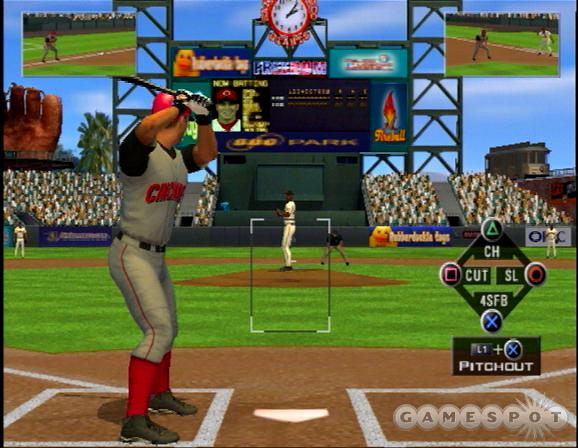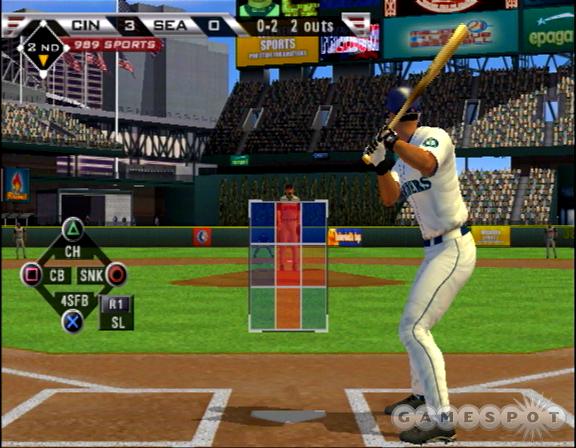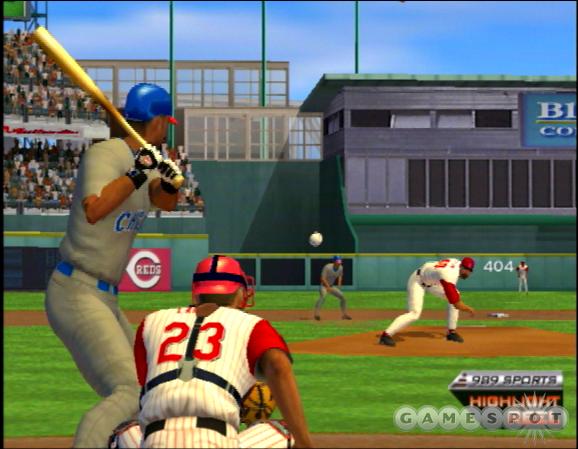989 Studios doesn't have the best reputation when it comes to sports games, but with the improvements made to the company's baseball game this year, that perception may start to change. Every aspect of this year's baseball game has been improved over MLB 2004. The graphics are better, the franchise mode is deeper, the controls offer a greater degree of precision, and the overall balance of the game has been adjusted so that home run blasts are no longer just as common as grounders and fly balls. MLB 2005 compares favorably to the other baseball games that are currently on the market, and while it may not delve as deeply into some areas as the rest do, there are numerous reasons why you might want to make it your baseball game of choice this season.

For instance, MLB 2005 offers a good degree of control over many aspects of play, but it doesn't go to the same extremes that other baseball games do. You don't have to deal with an esoteric meter to set the accuracy of each pitch. When you have a runner charging toward second base, you don't have to think about whether to perform a feet-first slide or a hook slide. The CPU handles these details for you. Some people like their baseball games as involved and complicated as possible, and some people just want a reasonable degree of control. MLB 2005 is aimed at those in the latter group. The pitching interface allows you to select a pitch, and then you target it toward the strike zone. How long you hold the X button during the windup determines how much power the pitcher puts behind the throw. You also have the option of making a pickoff play or throwing a pitchout, although strangely, there isn't an option for executing a quick intentional walk. The batting interface allows you to aim your swing to specific areas of the strike zone. You can further improve your chances of making contact by holding down the R2 button to guess what pitch is coming. The baserunning interface has been significantly improved so that now you can take control of an individual runner just by pressing one of the buttons on the front of the controller.
One of the biggest complaints that people have had with the MLB series in the past was that it has always been so easy to hit home runs. It wasn't uncommon in MLB 2004 to win every game played against the CPU by 10 runs or more. MLB 2005 still gives up too many base hits, but the number of long balls you'll see is much more believable on all difficulty settings. In general, the distribution of ground balls, liners, and pop flies is better than it was last year.
As far as play options are concerned, MLB 2005 offers the same set of modes that pretty much all baseball games have. One or two players can participate in exhibition matches, duke it out in a home run contest, or play through an entire season or playoff series. The franchise mode also lets a second player join in. The only play mode that doesn't support multiple players is the career mode--where you create a custom player and take him to spring training in the hopes that he'll be signed by a major league club. If you do well in spring training, you'll get to play for the club during the regular season. Every milestone you celebrate gives you more points to put toward the player's abilities. The career mode continues until your character retires or gets released, which can be at the end of the first spring training or many seasons down the line.

The franchise mode is delightfully comprehensive. It puts you in charge of all aspects of running a team for multiple seasons. This includes drafting a team, playing the games, hiring staff, trading players, and renegotiating contracts, as well as keeping track of more than a dozen different business, player development, and facilities options throughout the life of the franchise. You can set ticket and concession prices, buy new equipment for your locker room and medical facilities, spend money toward billboard and TV marketing campaigns, and even upgrade the team's travel arrangements. If your team isn't performing well in a particular area, you can give your coaching staff money to work on your players' hitting abilities, or the coaching staff can teach the pitching staff a new type of pitch, and more. Your success as a general manager is evaluated every five years, and if you earn a positive rating, you'll get your contract extended for another five years. About the only feature that's missing from the franchise mode is the ability to manage minor league teams (or to have your players called up from them).
Aside from its basic play modes, MLB 2005 also includes a number of compelling bonus features. The player editor supports the use of Sony's EyeToy PS2 camera, which means that you can take your face and put it onto the custom players you create. 989 Studios did a remarkable job with their face-mapping technology. Once you import a picture, all you need to do is stretch and twist the image around the three-dimensional head until you're happy with the likeness. The rewards menu is another nice feature. When you reach certain milestones during the course of a game--regardless of which mode you're playing--you earn points that you can spend in the rewards menu. The list of available rewards includes legendary players, old-time stadiums, throwback uniforms, cheat functions, and additional graphics settings. The prices are pretty down to Earth, and it only takes a couple of games to unlock all of the retro uniforms and a dozen or so of the 78 different legends players.
Online play is a big part of MLB 2005. If you have a Network Adaptor attached to your PS2, you can log on and participate in exhibition games and tournaments against other live players. There are chat rooms set up so that people can hang out with players who live in different regions of the US and Canada, and the message board and e-mail systems allow you to touch base with specific players. The system keeps track of statistics in roughly 30 different categories. Before you challenge someone, you can take a look at the total win/loss record, offensive stats, defensive stats, pitching stats, and number of times disconnected from games for that person. One of the nicest features of the online mode is that it lets players run custom tournaments. All you need to do to get a tourney going is set the rules, give it a name and password, and then invite your friends.

Unfortunately, downloadable roster updates aren't included in the list of online features. This is a boneheaded omission on the part of 989 Studios. Baseball fans always want to use the latest lineups, and it's so much easier to be able to just log on and download a complete update than it is to fiddle with a game's trade menu and player editor. The rosters that shipped with the game are from February 15, 2004, and reflect the blockbuster trade that sent Alex Rodriguez to the Yankees.
Assuming that you're interested in online play, you absolutely need a broadband connection to experience smooth, lag-free games. Batting is a nightmare when dial-up is involved. If you're using a dial-up account or if you're a broadband user playing against someone with a dial-up account, the game stutters and jerks so much that pitches literally freeze in midair and then suddenly appear in the catcher's glove. The lag also makes it nearly impossible to thwart stolen base attempts. Thankfully, you don't have to jump blindly into a game in the hope that your opponent is using broadband. The server tells you how good the connection is between you and the other person by listing the other person's ping delay next to his or her username. 100 or less seems to be the optimal score, and most broadband users tend to have ping scores below 100. With few exceptions, dial-up users end up with pings of 200 or more.
Broadband users can take advantage of USB headset support to chat with opponents during online games. What is surprising, though, is that the game also supports the use of a headset for issuing voice recognition commands to your defense during offline games, which is similar to the way voice recognition is used in SOCOM: US Navy SEALs. By pressing in on the right analog stick, you can speak phrases into the microphone--like "infield in," "outfield deep," or "fork ball"--and the fielders and pitchers on your team will perform these commands.
In terms of atmosphere, MLB 2005 does a good job of capturing the sights and sounds found at an actual major league game. The crowd claps and boos in response to individual hits and strikeouts, and the volume level ratchets upward whenever an exciting play transpires. Individual fans stand up, clap, and cheer independently of one another, and many of them are wearing team colors and T-shirts--just like the fans do at a real ballpark. The announcements and advertisements that come out of the PA system are particularly charming. Looking around the stadium, you'll find all of the landmarks and signs that you'd expect to see in your favorite park. The scoreboards also update to show player photos and to reflect the current line score.
If you played MLB 2004 last year, you probably remember that it didn't do much to take advantage of the PS2's graphical capabilities. MLB 2005 is much better in this regard. The graphics are exceptionally clean, and the number of different camera angles used in replays more closely approximates what you'd see on a locally televised game. The player models are large, and their faces are generally accurate. Another thing that 989 Studios did to improve the look of its game was to lift a few ideas from its competitors--most notably the EA Sports' MVP Baseball series. Last year, EA Sports celebrated a number of firsts with MVP Baseball 2003. It was the first modern console baseball game to incorporate picture-in-picture baserunning-cameras. It was also the first console baseball game to feature player uniforms that got dirty from plays made on the field. Similarly, 989 Studios has included both of these features in MLB 2005. When you put it all together, MLB 2005 is a great-looking PS2 game.

Upon closer inspection, you may notice that some of the cute little details that make other baseball games so likable are either downplayed in or are missing entirely from MLB 2005. The variety of different animations for plays made in the field, plate rituals, and base hit celebrations is good, but many of these canned animations repeat numerous times during a single game. There isn't much going on in the surrounding environment either. Clouds don't drift across the sky, the shadows on the field remain fixed in place, and you never see any traffic--such as cars or airplanes--going about their business outside of the stadium. Likewise, the audio also feels somewhat restrained. Vin Scully and Dave Campbell call the game like they're at a funeral and only contribute a bare minimum of historical background information. The catcalls from the crowd are nice, but they aren't directed at specific players. Even the PA system could use an added jolt of energy, since the music clips that play when players come to the plate are unfamiliar, quiet, and brief. In the long run, these nitpicks don't take away all that much from the game's overall atmosphere, but they have to be mentioned since all of the other baseball games out right now have set the bar so high.
Even though it has a few rough spots, MLB 2005 is a very good, full-featured baseball game that should keep you pleasantly occupied throughout the season.